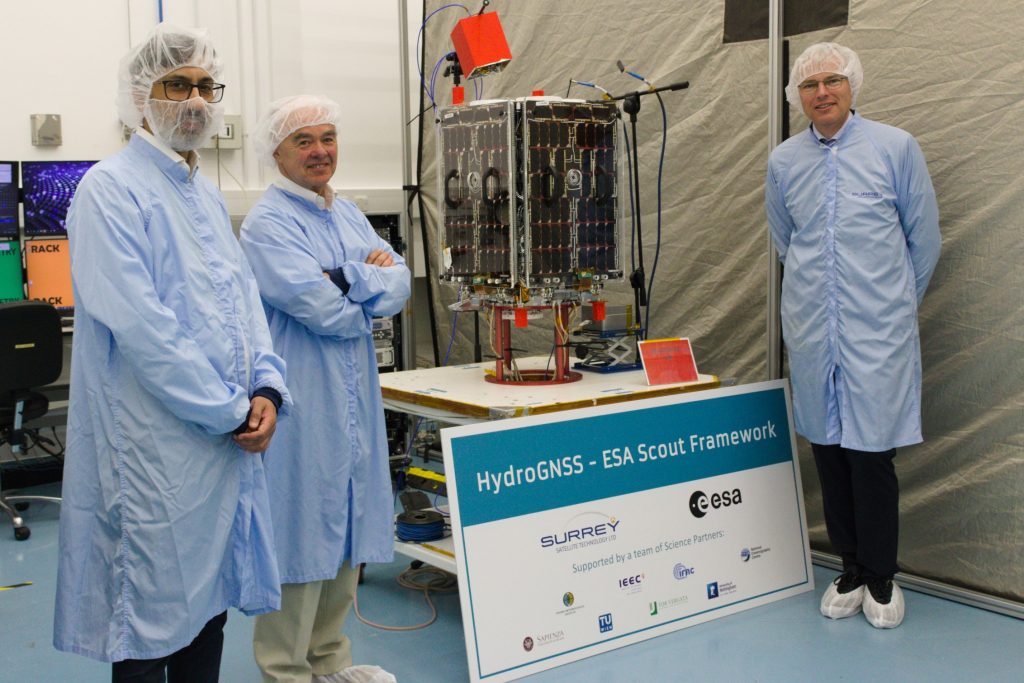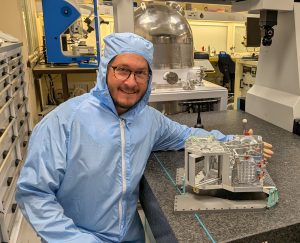A ground-breaking mission which will use space technology to tackle climate change on Earth has been showcased to an international community of experts ahead of its launch.
Surrey Satellite Technology Ltd (SSTL) is building the HydroGNSS satellites, which will provide vital Earth observation data to fill in the gaps in our monitoring of our planet’s vital signs.
The HydroGNSS mission originated from early-stage development sponsored by the CEOI, which provided critical seed funding to accelerate the technology development. This led onto an in-orbit demonstration on the UK TDS-1 mission, and the provision of payloads that enabled the NASA CYGNSS cyclone-sensing mission. The European Space Agency’s Scout Programme later supported full mission development towards the land-sensing HydroGNSS mission, building on this early UK-led innovation.
Last month, key members of the European scientific community visited SSTL to see the technology ahead of the satellites’ launch later this year.
CEOI Director Nicolas Lévêque said: “HydroGNSS will make a significant contribution to climate monitoring from space, and we’re proud to have supported the technology with grants worth £691,000 to SSTL and science partners in the National Oceanography Centre and Universities of Surrey, Bath and Nottingham.
“Through our funding of cutting-edge satellites like HydroGNSS, we’re enabling the UK to lead the way in climate monitoring and are empowering government to pinpoint emissions and deliver net-zero policies with unparalleled precision.”
The speakers at SSTL’s event included HydroGNSS Project Manager at ESA Jean-Pascal Lejault, UKSA’s Head of Missions and Capabilities Director Harshbir Sangha and SSTL’s Founder and Executive Chairman, Sir Martin Sweeting.
They underlined the scientific significance of the mission and its contribution to climate monitoring from space before guests were invited to see the satellites which are undergoing their final preparations ahead of their launch.
Andrew Cawthorne, Managing Director at SSTL, said: “HydroGNSS is a bold step forward in advancing affordable climate science from orbit and is a testament to the power of collaboration across agencies, academia, and industry.
“This mission will demonstrate how we can use reflections from the Earth of navigation signals from Global Navigation Satellite Systems to measure key climate variables such as soil moisture, forest biomass, freeze-thaw cycles, flooding and ocean wind speed.
“The small satellite technology used on HydroGNSS enables scientific measurement with a temporal-spatial resolution not accessible to traditional remote sensing satellites and will help to fill the gaps in our monitoring of the Earth’s vital signs for the future.
“As a result, it will assist with the fight against climate change by providing valuable measurements using space technology.”
The CEOI was created in 2007 and has been funded since 2011 by the UK Space Agency. The CEOI has distributed grants worth £26 million to more than 65 Earth observation technology projects since 2017. These instruments aid humanity’s understanding of our planet, its climate and natural processes, and they help inform the decision-making for building resilient societies.
For further information about Surrey Satellite Technology Ltd, visit https://www.sstl.co.uk.




